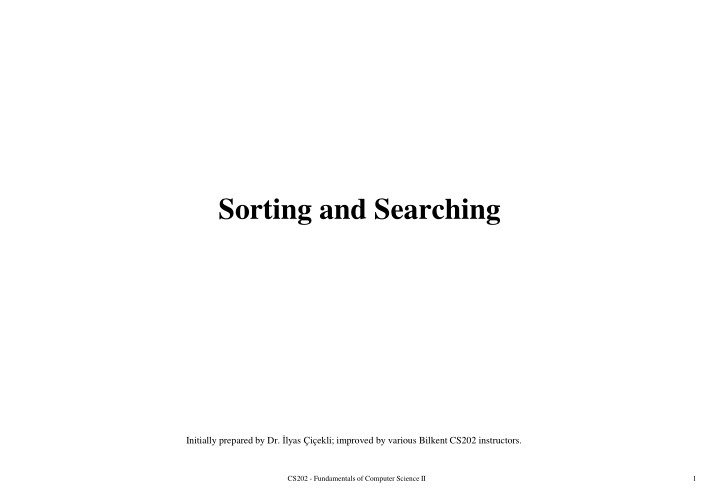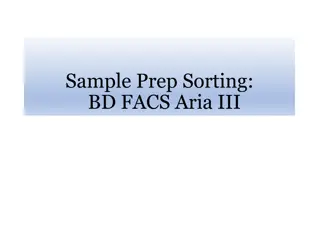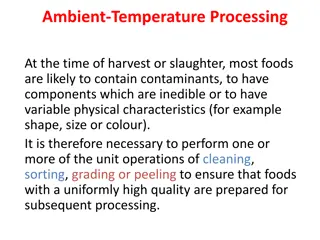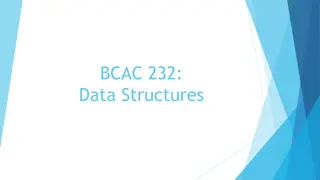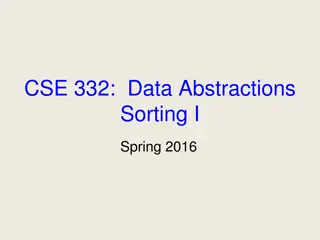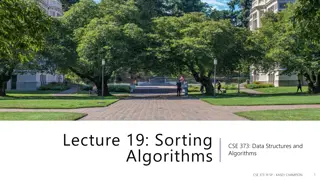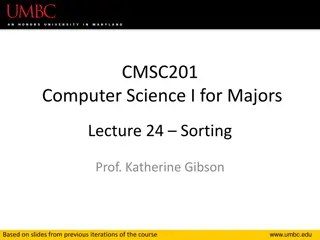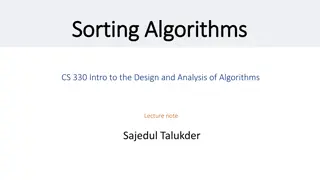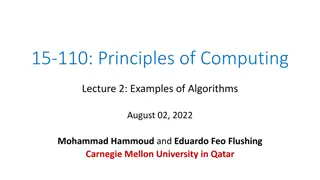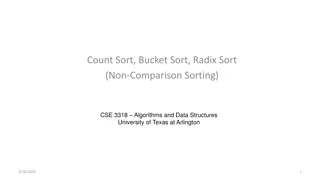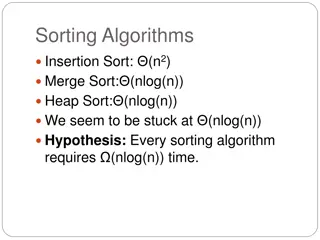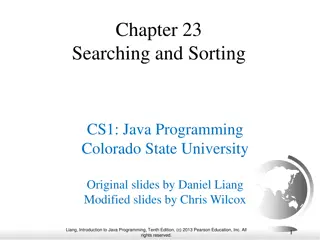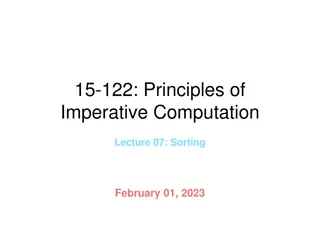Fundamental Sorting and Searching Concepts
This content covers the fundamentals of sorting and searching algorithms, including sequential search and binary search. It details the complexity analysis for both successful and unsuccessful searches. Additionally, it emphasizes the importance of sorting in computer science and the efficiency of binary search over other search methods.
Download Presentation

Please find below an Image/Link to download the presentation.
The content on the website is provided AS IS for your information and personal use only. It may not be sold, licensed, or shared on other websites without obtaining consent from the author.If you encounter any issues during the download, it is possible that the publisher has removed the file from their server.
You are allowed to download the files provided on this website for personal or commercial use, subject to the condition that they are used lawfully. All files are the property of their respective owners.
The content on the website is provided AS IS for your information and personal use only. It may not be sold, licensed, or shared on other websites without obtaining consent from the author.
E N D
Presentation Transcript
Sorting and Searching Initially prepared by Dr. lyas i ekli; improved by various Bilkent CS202 instructors. CS202 - Fundamentals of Computer Science II 1
Problem of the Day CS202 - Fundamentals of Computer Science II 2
Sequential Search int sequentialSearch( const int a[], int item, int n){ for (int i = 0; i < n && a[i]!= item; i++); if (i == n) return 1; return i; } Unsuccessful Search: O(n) Successful Search: Best-Case:item is in the first location of the array O(1) Worst-Case:item is in the last location of the array O(n) Average-Case: The number of key comparisons 1, 2, ..., n O(n) n n n = i + 2 ( / ) 2 n n = 1 i CS202 - Fundamentals of Computer Science II 3
Binary Search int binarySearch( int a[], int size, int x) { int low =0; int high = size 1; int mid; // mid will be the index of // target when it s found. while (low <= high) { mid = (low + high)/2; if (a[mid] < x) low = mid + 1; else if (a[mid] > x) high = mid 1; else return mid; } return 1; } CS202 - Fundamentals of Computer Science II 4
Binary Search Analysis For an unsuccessful search: The number of iterations in the loop is log2n + 1 O(log2n) For a successful search: Best-Case: The number of iterations is 1 Worst-Case: The number of iterations is log2n +1 O(log2n) Average-Case: The avg. # of iterations < log2n O(1) O(log2n) 0 1 2 3 4 5 6 7 an array with size 8 3 2 3 1 3 2 3 4 # of iterations The average # of iterations = 21/8 < log28 CS202 - Fundamentals of Computer Science II 5
How much better is O(log2n)? n O(log2n) 4 6 8 10 14 17 18 19 20 30 16 64 256 1024 (1KB) 16,384 131,072 262,144 524,288 1,048,576 (1MB) 1,073,741,824 (1GB) CS202 - Fundamentals of Computer Science II 6
Sorting CS202 - Fundamentals of Computer Science II 7
Importance of Sorting Why don t CS profs ever stop talking about sorting? 1. Computers spend more time sorting than anything else, historically 25% on mainframes. 2. Sorting is the best studied problem in computer science, with a variety of different algorithms known. 3. Most of the interesting ideas we will encounter in the course can be taught in the context of sorting, such as divide-and-conquer, randomized algorithms, and lower bounds. (slide by Steven Skiena) CS202 - Fundamentals of Computer Science II 8
Sorting Organize data into ascending / descending order Useful in many applications Any examples can you think of? Internal sort vs. external sort We will analyze only internal sorting algorithms Sorting also has other uses. It can make an algorithm faster. e.g., find the intersection of two sets CS202 - Fundamentals of Computer Science II 9
Efficiency of Sorting Sorting is important because once a set of items is sorted, many other problems become easy. Furthermore, using O(n log n) sorting algorithms leads naturally to sub- quadratic algorithms for these problems. Large-scale data processing would be impossible if sorting took O(n2) time. (slide by Steven Skiena) CS202 - Fundamentals of Computer Science II 10
Applications of Sorting Closest Pair: Given n numbers, find the pair which are closest to each other. Once the numbers are sorted, the closest pair will be next to each other in sorted order, so an O(n) linear scan completes the job. Complexity of this process: O(??) Element Uniqueness: Given a set of n items, are they all unique or are there any duplicates? Sort them and do a linear scan to check all adjacent pairs. This is a special case of closest pair above. Complexity? Mode: Given a set of n items, which element occurs the largest number of times? More generally, compute the frequency distribution. How would you solve it? CS202 - Fundamentals of Computer Science II 11
Sorting Algorithms There are many sorting algorithms, such as: Selection Sort Insertion Sort Bubble Sort Merge Sort Quick Sort First three sorting algorithms are not so efficient, but last two are efficient sorting algorithms. CS202 - Fundamentals of Computer Science II 12
Selection Sort CS202 - Fundamentals of Computer Science II 13
Selection Sort List divided into two sublists, sorted and unsorted. Find the biggest element from the unsorted sublist. Swap it with the element at the end of the unsorted data. After each selection and swapping, imaginary wall between the two sublists move one element back. Sort pass: Each time we move one element from the unsorted sublist to the sorted sublist, we say that we have completed a sort pass. A list of n elements requires n-1 passes to completely sort data. CS202 - Fundamentals of Computer Science II 14
Selection Sort (cont.) CS202 - Fundamentals of Computer Science II 15
Selection Sort (cont.) typedef type-of-array-item DataType; void selectionSort( DataType theArray[], int n) { for (int last = n-1; last >= 1; --last) { int largest = indexOfLargest(theArray, last+1); swap(theArray[largest], theArray[last]); } } CS202 - Fundamentals of Computer Science II 16
Selection Sort (cont.) int indexOfLargest(const DataType theArray[], int size) { int indexSoFar = 0; for (int currentIndex=1; currentIndex<size;++currentIndex) { if (theArray[currentIndex] > theArray[indexSoFar]) indexSoFar = currentIndex; } return indexSoFar; } -------------------------------------------------------- void swap(DataType &x, DataType &y) { DataType temp = x; x = y; y = temp; } CS202 - Fundamentals of Computer Science II 17
Selection Sort -- Analysis To analyze sorting, count simple operations For sorting, important simple operations: key comparisons and number of moves In selectionSort() function, the for loop executes n-1 times. In selectionSort() function, we invoke swap() once at each iteration. Total Swaps: n-1 Total Moves: 3*(n-1) (Each swap has three moves) CS202 - Fundamentals of Computer Science II 18
Selection Sort Analysis (cont.) In indexOfLargest() function, the for loop executes (from n-1 to 1), and each iteration we make one key comparison. # of key comparisons = 1+2+...+n-1 = n*(n-1)/2 So, Selection sort is O(n2) The best case, worst case, and average case are the same all O(n2) Meaning: behavior of selection sort does not depend on initial organization of data. Since O(n2) grows so rapidly, the selection sort algorithm is appropriate only for small n. Although selection sort requires O(n2) key comparisons, it only requires O(n) moves. Selection sort is good choice if data moves are costly but key comparisons are not costly (short keys, long records). CS202 - Fundamentals of Computer Science II 19
Insertion Sort CS202 - Fundamentals of Computer Science II 20
Insertion Sort Insertion sort is a simple sorting algorithm appropriate for small inputs. Most common sorting technique used by card players. List divided into two parts: sorted and unsorted. In each pass, the first element of the unsorted part is picked up, transferred to the sorted sublist, and inserted in place. List of n elements will take at most n-1 passes to sort data. CS202 - Fundamentals of Computer Science II 21
Insertion Sort: Basic Idea Assume input array: A[1..n] Iterate j from 2 to n already sorted j iter j insert into sorted array j after iter j sorted subarray 22 CS 202
Algorithm: Insertion Sort Insertion-Sort (A) 1. for j 2 to n do 2. key A[j]; 3. i j - 1; 4. while i > 0 and A[i] > key do 5. A[i+1] A[i]; 6. i i - 1; endwhile 7. A[i+1] key; endfor 23 CS 202
Algorithm: Insertion Sort Insertion-Sort (A) 1. for j 2 to n do 2. key A[j]; 3. i j - 1; 4. while i > 0 and A[i] > key do 5. A[i+1] A[i]; 6. i i - 1; endwhile 7. A[i+1] key; endfor Iterate over array elts j Loop invariant: The subarray A[1..j-1] is always sorted already sorted j key 24 CS 202
Algorithm: Insertion Sort Insertion-Sort (A) 1. for j 2 to n do 2. key A[j]; 3. i j - 1; 4. while i > 0 and A[i] > key do 5. A[i+1] A[i]; 6. i i - 1; endwhile 7. A[i+1] key; endfor Shift right the entries in A[1..j-1] that are > key already sorted j < key > key j < key > key 25 CS 202
Algorithm: Insertion Sort Insertion-Sort (A) 1. for j 2 to n do 2. key A[j]; 3. i j - 1; 4. while i > 0 and A[i] > key do 5. A[i+1] A[i]; 6. i i - 1; endwhile 7. A[i+1] key; endfor key j < key > key now sorted Insert key to the correct location End of iter j: A[1..j] is sorted 26 CS 202
Insertion Sort - Example Insertion-Sort (A) 1. for j 2 to n do 2. key A[j]; 3. i j - 1; 4. while i > 0 and A[i] > key do 5. A[i+1] A[i]; 6. i i - 1; endwhile 7. A[i+1] key; endfor 5 2 4 6 1 3 27 CS 202
Insertion Sort - Example: Iteration j=2 Insertion-Sort (A) 1. for j 2 to n do 2. key A[j]; 3. i j - 1; 4. while i > 0 and A[i] > key do 5. A[i+1] A[i]; 6. i i - 1; endwhile 7. A[i+1] key; endfor key=2 j 5 2 4 6 1 3 initial sorted > 2j 5 2 4 6 1 3 shift sorted insert key 2 5 4 6 1 3 28 CS 202
Insertion Sort - Example: Iteration j=3 Insertion-Sort (A) 1. for j 2 to n do 2. key A[j]; 3. i j - 1; 4. while i > 0 and A[i] > key do 5. A[i+1] A[i]; 6. i i - 1; endwhile 7. A[i+1] key; endfor key=4 j 2 5 4 6 1 3 initial sorted What are the entries at the end of iteration j=3? ? ? ? ? ? ? 29 CS 202
Insertion Sort - Example: Iteration j=3 Insertion-Sort (A) 1. for j 2 to n do 2. key A[j]; 3. i j - 1; 4. while i > 0 and A[i] > key do 5. A[i+1] A[i]; 6. i i - 1; endwhile 7. A[i+1] key; endfor key=4 j 2 5 4 6 1 3 initial sorted j < 4 > 4 2 5 4 6 1 3 shift sorted insert key 2 4 5 6 1 3 30 CS 202
Insertion Sort - Example: Iteration j=4 Insertion-Sort (A) 1. for j 2 to n do 2. key A[j]; 3. i j - 1; 4. while i > 0 and A[i] > key do 5. A[i+1] A[i]; 6. i i - 1; endwhile 7. A[i+1] key; endfor key=6 j 2 4 5 6 1 3 initial sorted < 6j 2 4 5 6 1 3 shift sorted insert key 2 4 5 6 1 3 31 CS 202
Insertion Sort - Example: Iteration j=5 Insertion-Sort (A) 1. for j 2 to n do 2. key A[j]; 3. i j - 1; 4. while i > 0 and A[i] > key do 5. A[i+1] A[i]; 6. i i - 1; endwhile 7. A[i+1] key; endfor key=1 j 2 4 5 6 1 3 initial sorted What are the entries at the end of iteration j=5? ? ? ? ? ? ? 32 CS 202
Insertion Sort - Example: Iteration j=5 Insertion-Sort (A) 1. for j 2 to n do 2. key A[j]; 3. i j - 1; 4. while i > 0 and A[i] > key do 5. A[i+1] A[i]; 6. i i - 1; endwhile 7. A[i+1] key; endfor key=1 j 2 4 5 6 1 3 initial sorted j >1 >1 >1 >1 2 4 5 6 1 3 shift sorted insert key 1 2 4 5 6 3 33 CS 202
Insertion Sort - Example: Iteration j=6 Insertion-Sort (A) 1. for j 2 to n do 2. key A[j]; 3. i j - 1; 4. while i > 0 and A[i] > key do 5. A[i+1] A[i]; 6. i i - 1; endwhile 7. A[i+1] key; endfor key=3 j 1 2 4 5 6 3 initial sorted j <3 >3 >3 >3 1 2 4 5 6 3 shift sorted insert key 1 2 3 4 5 6 34 CS 202
Insertion Sort Algorithm - Notes Items sorted in-place Elements rearranged within array At most constant number of items stored outside the array at any time (e.g. the variable key) Input array A contains sorted output sequence when the algorithm ends Incremental approach Having sorted A[1..j-1], place A[j] correctly so that A[1..j] is sorted 35 CS 202
Insertion Sort (in C++) void insertionSort(DataType theArray[], int n) { for (int unsorted = 1; unsorted < n; ++unsorted) { DataType nextItem = theArray[unsorted]; int loc = unsorted; for ( theArray[loc] = theArray[loc-1]; ;(loc > 0) && (theArray[loc-1] > nextItem); --loc) theArray[loc] = nextItem; } } CS202 - Fundamentals of Computer Science II 36
Insertion Sort (cont.) Sorted Unsorted CS202 - Fundamentals of Computer Science II 37
Insertion Sort Analysis What is the complexity of insertion sort? Depends on array contents Best-case: Array is already sorted in ascending order. Inner loop will not be executed. The number of moves: 2*(n-1) The number of key comparisons: (n-1) Worst-case: Array is in reverse order: Inner loop is executed p-1 times, for p = 2,3, , n The number of moves: 2*(n-1)+(1+2+...+n-1)= 2*(n-1)+ n*(n-1)/2 The number of key comparisons: (1+2+...+n-1)= n*(n-1)/2 Average-case: O(n2) We have to look at all possible initial data organizations. So, Insertion Sort is O(n2) O(n) O(n) O(n) O(n2) O(n2) O(n2) CS202 - Fundamentals of Computer Science II 38
Insertion Sort Analysis Which running time will be used to characterize this algorithm? Best, worst or average? Worst case: Longest running time (this is the upper limit for the algorithm) It is guaranteed that the algorithm will not be worse than this. Sometimes we are interested in average case. But there are problems: Difficult to figure out average case. i.e. what is the average input? Are we going to assume all possible inputs are equally likely? In fact, for most algorithms average case is the same as the worst case. CS202 - Fundamentals of Computer Science II 39
Bubble Sort CS202 - Fundamentals of Computer Science II 40
Bubble Sort List divided into two sublists: sorted and unsorted. The largest element is bubbled from the unsorted list and moved to the sorted sublist. After that, the wall moves one element back, increasing the number of sorted elements and decreasing the number of unsorted ones. One sort pass: each time an element moves from the unsorted part to the sorted part. Given a list of n elements, bubble sort requires up to n-1 passes (maximum passes) to sort data. CS202 - Fundamentals of Computer Science II 41
Bubble Sort (cont.) CS202 - Fundamentals of Computer Science II 42
Bubble Sort (cont.) void bubbleSort( DataType theArray[], int n) { bool sorted = false; for (int pass = 1; (pass < n) && !sorted; ++pass) { sorted = true; for (int index = 0; index < n-pass; ++index) { int nextIndex = index + 1; if (theArray[index] > theArray[nextIndex]) { swap(theArray[index], theArray[nextIndex]); sorted = false; // signal exchange } } } } CS202 - Fundamentals of Computer Science II 43
Bubble Sort Analysis Worst-case: Array is in reverse order: Inner loop is executed n-1 times, The number of moves: 3*(1+2+...+n-1) = 3 * n*(n-1)/2 The number of key comparisons: (1+2+...+n-1)= n*(n-1)/2 Best-case: O(n) Array is already sorted in ascending order. The number of moves: 0 The number of key comparisons: (n-1) Average-case: O(n2) We have to look at all possible initial data organizations. So, Bubble Sort is O(n2) O(n2) O(n2) O(n2) O(1) O(n) CS202 - Fundamentals of Computer Science II 44
Merge Sort CS202 - Fundamentals of Computer Science II 45
Mergesort One of two important divide-and-conquer sorting algorithms Other one is Quicksort It is a recursive algorithm. Divide the list into halves, Sort each half separately, and Then merge the sorted halves into one sorted array. CS202 - Fundamentals of Computer Science II 46
Merge Sort: Basic Idea Input array A Divide sort this half sort this half Conquer merge two sorted halves Combine 47 CS 202
Merge-Sort (A, p, r) if p = r then return; else q (p+r)/2 ; Merge-Sort (A, p, q); Merge-Sort (A, q+1, r); Merge (A, p, q, r); endif (Divide) (Conquer) (Conquer) (Combine) Call Merge-Sort(A,1,n) to sort A[1..n] Recursion bottoms out when subsequences have length 1 48
Merge Sort: Example Merge-Sort (A, p, r) p q r 5 2 4 6 1 3 if p = r then return else q (p+r)/2 Merge-Sort (A, p, q) Merge-Sort (A, q+1, r) p q r 2 4 5 1 3 6 1 2 3 4 5 6 Merge(A, p, q, r) endif 49 CS 202
How to merge 2 sorted subarrays? 2 4 5 A[p..q] 1 2 3 4 5 6 1 3 6 A[q+1..r] (n) What is the complexity of this step? 50 CS 202
